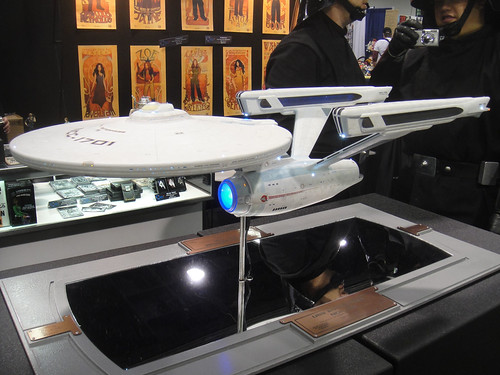In this world there are visionaries, geniuses (or genii, if you like) and people who see further than their fellow man. But then, just a hair’s breadth away, are those who see to far, whose ideas are too great for this world. This article is a shrine to those whose ideas passed the line from genius into insanity, and the world is a less interesting place because their ideas weren’t realised. Ideas like:
A Life-Sized Starship Enterprise in Las Vegas

It sounds like a geek’s wet dream, but in 1992 there were plans to actually make this happen. Las Vegas wasn’t bringing in as many tourist dollars as they’d like, so they held a competition to design an attraction that would draw in tourists.
Leading the pack was the Gary Goddard Group, who proposed a 1:1 scale model of the U.S.S Enterprise. The finished structure would be as long as the Eiffel Tower is tall, and would have held all the key rooms from the ship in the original series, including the bridge, engineering and crew quarters. Business owners in Vegas and Paramount Licensing both loved the idea, and it looked like Vegas was going to have its own Starship Enterprise right there on the strip.
Stanley Jaffe, the president and COO of Paramount Communications was sought for approval.
He said, “In the movie business, when we produce a big movie and it’s a flop – we take some bad press for a few weeks or a few months, but then it goes away. The next movie comes out and everyone forgets. But THIS – this is different. If this doesn’t work – if this is not a success – it’s there, forever…”
In short, Jaffe was given the chance to make the most awesome geek attraction on the entire planet, and he wussed out. He was afraid of being remembered for Paramount’s biggest flop, instead he’s remembered for ruining the geeky dreams of a generation.
A Rollercoaster That Would Literally Kill You
If you’re anything like me then you’re probably terrified of rollercoasters. Moving at super-fast speeds and hoping that a loose bolt somewhere does send you and your fellow passengers hurtling into a brick wall is not everyone’s idea of a good time. Of course, I’m sure it would all be less frightening if you knew the rollercoaster was designed to kill you.
The Euthanasia Coaster was a steel rollercoaster designed in 2010. It was designed by Julijonas Urbonas, a PhD candidate at the Royal College of Art in London, who said he designed the rollercoaster to kill people with “with elegance and euphoria”, presumably before rubbing his hands together and cackling madly as a bolt of lightning struck a tree in the background.
The cause of death would be prolonged cerebral hypoxia, or insufficient supply of oxygen to the brain. Of course, the odds of anyone building an actual death coaster are incredibly slim, and the design was a proof of concept more than anything else.
Of course, that didn’t stop anti-euthanasia group Care Not Killing taking the time to protest the non-existence coaster, saying “Euthanasia rightly remains illegal. Let’s hope this imaginative method never becomes legal.”
The Illinois Mile-High Would Have Dwarfed the Burj Khalifa
Ever since one caveman put one rock on top of another rock, and another caveman responded by putting three rocks one on top of the other, humans have been obsessed with building really tall things. The current holder of the title of Tallest Thing is the Burj Khalifa at a little over half a mile tall.
But it would have looked a little on the short and dumpy side if Frank Lloyd Wright had got his way 1956. This tower would have been a mile tall. While Wright believed that the design was technically possible, there were a number of flaws. These included the best building material at the time, steel, being, believe it or not too flexible. This meant that in a strong (or any) wind, the tower would have swayed in the wind like a tall grass reed.
Another problem, was of course, that it ould have required a hell of a lot of windows, and Anglian windows wasn’t about yet to give them a great double-glazing offer.
Still, years later we have the Burj Khalifa, and although it’s only half the size of Frank Lloyd Wright’s design, there are definite similarities.
Chris Farnell is a freelance writer who covers construction and design issues.
